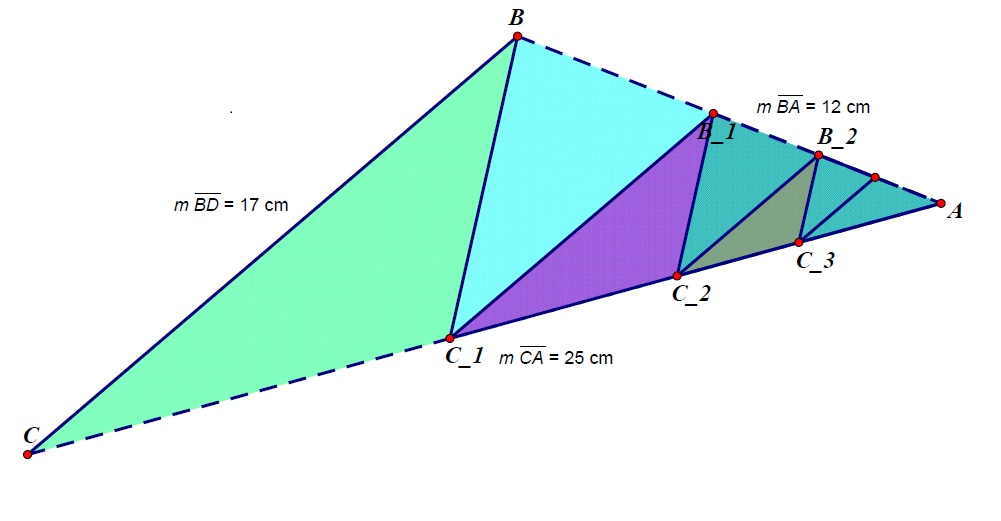Difference between revisions of "2013 AIME I Problems/Problem 13"
Michelangelo (talk | contribs) (→Solution) |
|||
| Line 1: | Line 1: | ||
| − | |||
== Problem 13 == | == Problem 13 == | ||
Triangle <math>AB_0C_0</math> has side lengths <math>AB_0 = 12</math>, <math>B_0C_0 = 17</math>, and <math>C_0A = 25</math>. For each positive integer <math>n</math>, points <math>B_n</math> and <math>C_n</math> are located on <math>\overline{AB_{n-1}}</math> and <math>\overline{AC_{n-1}}</math>, respectively, creating three similar triangles <math>\triangle AB_nC_n \sim \triangle B_{n-1}C_nC_{n-1} \sim \triangle AB_{n-1}C_{n-1}</math>. The area of the union of all triangles <math>B_{n-1}C_nB_n</math> for <math>n\geq1</math> can be expressed as <math>\tfrac pq</math>, where <math>p</math> and <math>q</math> are relatively prime positive integers. Find <math>q</math>. | Triangle <math>AB_0C_0</math> has side lengths <math>AB_0 = 12</math>, <math>B_0C_0 = 17</math>, and <math>C_0A = 25</math>. For each positive integer <math>n</math>, points <math>B_n</math> and <math>C_n</math> are located on <math>\overline{AB_{n-1}}</math> and <math>\overline{AC_{n-1}}</math>, respectively, creating three similar triangles <math>\triangle AB_nC_n \sim \triangle B_{n-1}C_nC_{n-1} \sim \triangle AB_{n-1}C_{n-1}</math>. The area of the union of all triangles <math>B_{n-1}C_nB_n</math> for <math>n\geq1</math> can be expressed as <math>\tfrac pq</math>, where <math>p</math> and <math>q</math> are relatively prime positive integers. Find <math>q</math>. | ||
| Line 21: | Line 20: | ||
== See also == | == See also == | ||
{{AIME box|year=2013|n=I|num-b=12|num-a=14}} | {{AIME box|year=2013|n=I|num-b=12|num-a=14}} | ||
| + | {{MAA Notice}} | ||
Revision as of 14:05, 4 July 2013
Problem 13
Triangle ![]() has side lengths
has side lengths ![]() ,
, ![]() , and
, and ![]() . For each positive integer
. For each positive integer ![]() , points
, points ![]() and
and ![]() are located on
are located on ![]() and
and ![]() , respectively, creating three similar triangles
, respectively, creating three similar triangles ![]() . The area of the union of all triangles
. The area of the union of all triangles ![]() for
for ![]() can be expressed as
can be expressed as ![]() , where
, where ![]() and
and ![]() are relatively prime positive integers. Find
are relatively prime positive integers. Find ![]() .
.
Solution
(solution)
Using Heron's Formula we can get the area of the triangle ![]() . Since
. Since ![]() then the scale factor for the dimensions of
then the scale factor for the dimensions of ![]() to
to ![]() is
is ![]() Therefore, the area of
Therefore, the area of ![]() is
is ![]() . Also, the dimensions of the other sides of the
. Also, the dimensions of the other sides of the ![]() can be
easily computed:
can be
easily computed: ![]() and
and ![]() . This allows us to compute one side of the
triangle
. This allows us to compute one side of the
triangle ![]() ,
, ![]() . Therefore, the scale factor
. Therefore, the scale factor ![]() to
to ![]() is
is ![]() , which yields the length of
, which yields the length of ![]() as
as ![]() .
Therefore, the scale factor for
.
Therefore, the scale factor for ![]() to
to ![]() is
is ![]() . Some more algebraic manipulation will show that
. Some more algebraic manipulation will show that ![]() to
to ![]() is still
is still ![]() . Also, since the triangles are disjoint, the area of the union is the sum of the areas. Therefore, the area is the geometric series
. Also, since the triangles are disjoint, the area of the union is the sum of the areas. Therefore, the area is the geometric series
![]() At this point, it may be wise to "simplify"
At this point, it may be wise to "simplify" ![]() .
So the geometric series converges to
.
So the geometric series converges to
 .
Using the diffference of squares, we get
.
Using the diffference of squares, we get ![]() , which simplifies to
, which simplifies to ![]() . Cancellling all common factors, we get the reduced fraction,
. Cancellling all common factors, we get the reduced fraction, ![]() , yielding the answer
, yielding the answer ![]() .
.
See also
| 2013 AIME I (Problems • Answer Key • Resources) | ||
| Preceded by Problem 12 |
Followed by Problem 14 | |
| 1 • 2 • 3 • 4 • 5 • 6 • 7 • 8 • 9 • 10 • 11 • 12 • 13 • 14 • 15 | ||
| All AIME Problems and Solutions | ||
The problems on this page are copyrighted by the Mathematical Association of America's American Mathematics Competitions. 










